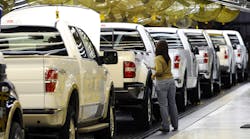“Cooperative federalism doesn’t mean 1 state can dictate standards for the rest of the country. @EPA will set a nat’l standard for GHG emissions that allows auto manufacturers to make cars ppl want & can afford, while still expanding environmental & safety benefits of newer cars.” —Scott Pruitt, head of the Environmental Protection Agency, via Twitter yesterday.
The Environmental Protection Agency (EPA) officially wrapped up its year-long Midterm Evaluation (MTE) process for the greenhouse gas (GHG) emissions standards for car and light truck model years (MY) 2022 through 2025 – and the findings from that review are already churning the political and policy waters.
The agency determined that, in light of recent data, the current standards are “not appropriate and should be revised.” Thus, EPA Administrator Scott Pruitt also announced late yesterday the start of a joint process with the National Highway Traffic Safety Administration (NHTSA) to develop a notice and comment rulemaking to set more appropriate GHG emissions standards and Corporate Average Fuel Economy (CAFE) standards.
“The Obama Administration's determination was wrong,” Pruitt said in a statement. “Obama’s EPA cut the MTE process short with politically charged expediency, made assumptions about the standards that didn’t comport with reality, and set the standards too high.”
Under the Clean Air Act (CAA), EPA sets national standards for vehicle tailpipe emissions of certain pollutants. Through a CAA waiver previously granted by EPA, California can impose stricter standards for vehicle emissions of certain pollutants than federal requirements but that controversial waiver is still being reexamined by the agency.
“Cooperative federalism doesn’t mean that one state can dictate standards for the rest of the country,” Pruitt noted. “EPA will set a national standard for greenhouse gas emissions that allows auto manufacturers to make cars that people both want and can afford — while still expanding environmental and safety benefits of newer cars. It is in America's best interest to have a national standard, and we look forward to partnering with all states, including California, as we work to finalize that standard.”
[The fear that California would “go it alone” and create an entire separate set of standards is one of trucking’s biggest fears where the EPA’s current GHG revision efforts are concerned.]
Many groups were quick to denounce the EPA’s findings, even before they’d been made official.
“Today’s announcement will create additional uncertainty and extend the process by which clear 2025 targets will be established,” noted John Boesel, president and CEO of CALSTART. “Our recent confidential survey shows that suppliers see the current fuel economy standards as good for jobs and good for investment. The suppliers not only back the current standards but are also very supportive of the three agencies working together to establish new ones for the 2026-2032 period.”
“Auto manufacturers have invested billions in a wide range of proven technologies that improve fuel economy and reduce emissions,” said Bob Perciasepe, president of the Center for Climate and Energy Solutions. “These are the very innovations envisioned when the current vehicle standards were adopted. If properly crafted, modest adjustments to the standards could make cleaner cars more affordable to more consumers without compromising on environmental objectives. Automakers could, for instance, be granted more time to meet more ambitious standards.”
He stressed that if EPA “is intent on weakening” federal GHG light vehicle standards, “it must continue to respect states’ rights” to enforce stronger ones.
“Congress explicitly allowed for a federalist approach in the implementation of the CAA,” Perciasepe noted. “California and a dozen other states, which together comprise almost 40% of the U.S. light duty automobile market, have demonstrated their strong commitment to public health and climate protection. It would be a major mistake to discount these state goals in favor of litigation and uncertainty for America’s automobile manufacturers.”
Yet other groups think the EPA’s decisions resulting from its MTE effort are the right ones – and hope to scuttle the GHG “carve out” given to California.
“Manufacturers support the greenhouse gas emissions and fuel economy program for automobiles. We agree with the EPA that the program should be updated based on lessons that have been learned from prior years, using the most current data,” said Ross Eisenberg, vice president for energy and resources policy for the National Association of Manufacturers. “Ultimately, manufacturers need a single national program that provides regulatory certainty and maintains vehicle affordability.”
“NADA has long supported a data-driven and informed process for determining future greenhouse gas and fuel economy standards, and we applaud EPA for putting us back on this path,” added Peter Welch, the group’s president and CEO. [FYI: NADA used to be known as the “National Automobile Dealers Association.”]
“America’s franchised auto dealers fully support continuous improvements in fuel economy and vehicle emissions, and we fully support fuel economy requirements that will allow us to build on the progress we’ve already achieved while keeping new vehicles affordable,” he said. “Standards alone – whatever they are – won’t do the trick. But smart standards that maintain affordability and encourage fleet turnover will help maximize the number of cleaner, safer and more fuel-efficient vehicles we get on the road every year.”
Welch’s point that “standards alone … won’t do the trick” is a good one, especially where commercial trucks are concerned.
One of the interesting issues with the heavy truck and trailer GHG rules – aside, of course, from their cost – is that they place the burden of compliance upon OEMs, not the end user. Thus if the vehicle’s owner decides to use a different grade of engine oil, or replace more expensive low-rolling resistance tires with cheaper models, or remove tractor and trailer fairings to get better curb clearance for urban operations, or any of a half-dozen other things, then the fuel savings pegged to the vehicle’s original spec when it left the factory may be less than expected – if not eliminated altogether.
[As an aside, about two years ago, the argument was made that all of the fuel savings expected to be generated by Phase 2 GHG rules pretty much evaporate when compared to the amount of fuel wasted by heavy trucks sitting idle every year in traffic congestion.]
And of course how a truck or tractor-trailer is driven probably determines the vehicle’s ultimate fuel economy numbers at the end of the day.
Those are things to keep in mind as the battle over revising the GHG regulations for cars and light trucks gets started.



